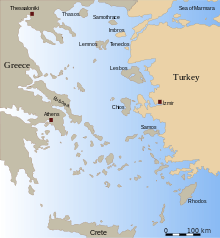Mochlos
| Native name: Μόχλος | |
|---|---|
 The island of Mochlos with town in the foreground. | |
| Geography | |
| Coordinates | 35°11′25″N 25°54′33″E / 35.19028°N 25.90917°E |
| Archipelago | Cretan Islands |
| Administration | |
|
Greece | |
| Region | Crete |
| Regional unit | Lasithi |
| Capital city | Mochlos, Crete |
| Demographics | |
| Population | 0 (2001) |
Mochlos (Greek: Μόχλος) is a modern island in the Gulf of Mirabello in eastern Crete, and the archaeological site of an ancient Minoan settlement. There is evidence that Mochlos was not an island in Minoan times, but was attached to the mainland and acted as an eastern harbor.
The name Mochlos also applies to the small fishing village and resort located on the main island of Crete, opposite Mochlos island. Only 150 metres separates them. The island is administered from Tourloti which is only 9 km (6 mi) away.
Archaeology
Mochlos was first excavated by Richard Seager in 1908 at the western end of the island, where a prepalatial cemetery was found. At that time, tombs, pithos burials and pit graves were uncovered, as well as two large tombs at the western tip of the island. In the 1970s, Jeffrey Soles documented the tombs and cemetery uncovered by Seager. The cemetery was in use from Early Minoan II to Middle Minoan IA.
The main Minoan settlement is at the south end of the island. The earliest buildings are from Early Minoan IB and the ruins visible today on Mochlos date from Late Minoan IB. Northwest of the modern town of Mochlos, a three-storey building was found from the Late Minoan I period. The building included two pillar crypts, a staircase and a kitchen. This building is the largest of the Late Minoan I town.
Two buildings were also uncovered behind the modern town of Mochlos. Both are artisans' quarters. One was used for crafting bronze, ivory and stone. The other was for making pottery. Both buildings contained a shrine. Excavations continued 1989-1994 under the direction of Jeffrey Soles from the University of North Carolina at Greensboro and Costis Davaras from the University of Athens. Some excavations continue, but the core work on the project is study and publication of data.
According to Keith Branigan,
"On present evidence, Mochlos was one of the largest Early Minoan settlements in Crete, much smaller than Knossos or Mallia, but comparable to Phaistos and perhaps Palaikastro, and certainly much larger than Myrtos, or Vasiliki."[1]
Metalwork

Ten Late Minoan I metal hoards were recently excavated at Mochlos. Among them are foundry hoards, traders' hoards and ceremonial assemblages. Lead isotope analyses indicate that copper oxhide ingots and fragments from these hoards originated in Cyprus.[2][3]
Large quantities of Early Minoan gold jewelry were excavated at Mochlos.
List of Minoan sites on Mochlos
- EMII-MMIA cemetery, western Mochlos
- EMIB-LMIB settlement, southern Mochlos
- LMIB artisans' quarters, near Mochlos
- LMIB building, eastern Mochlos, at Chalinmouri
- LMIII settlement
- LMIII cemetery
Visual impressions
 Mochlos beach
Mochlos beach highest village building
highest village building Church Agios Titos
Church Agios Titos Street
Street View to the Tavernas
View to the Tavernas
| Wikimedia Commons has media related to Mochlos. |
References
- ↑ Keith Branigan (1991), Mochlos. An Early Aegean Gateway Community. in R. Laffineur and L. Basch, Eds., Thalassa: L'Égée préhistorique et la mer [Aegaeum 7], 97- 105.
- ↑ Bryn Mawr Classical Review, 2009
- ↑ Jeffrey Soles, Metal Hoards from LM IB Mochlos, Crete, 143-156. in Iris Tzachili (ed.), Aegean Metallurgy in the Bronze Age: Proceedings of an International Symposium Held at the University of Crete, Rethymnon, Greece, on November 19–21, 2004. Athens: Ta Pragmata Publications, 2008. Pp. 345. ISBN 9789609826105
- Swindale, Ian http://www.minoancrete.com/mochlos.htm Retrieved 4 February 2006
External links
- http://www.minoancrete.com/mochlos.htm
- http://www.uncg.edu/~jssoles/Mochlos/first.html The Mochlos Excavation Project
Coordinates: 35°11.25′N 25°54.33′E / 35.18750°N 25.90550°E
